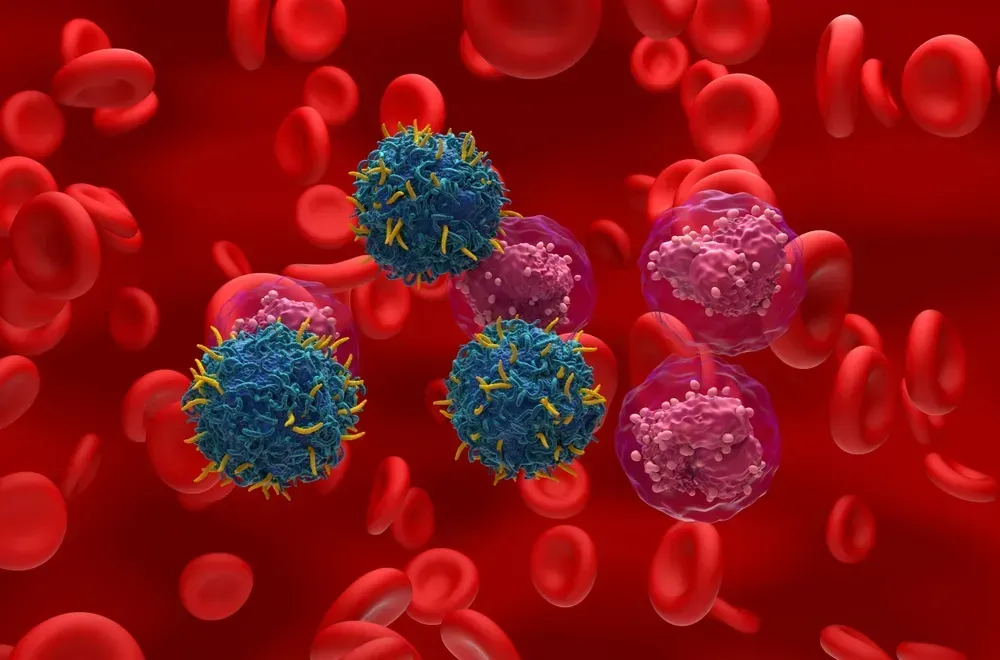EHA 2023: Effective Management of Bispecific Antibody Side Effects in Myeloma

Bispeific antibodies are up-and-coming therapies in myeloma but come with their own set of side effects that can include cytokine release syndrome (CRS), neurological effects (ICANS), infection risk and other issues.
At the European Hematology Association (EHA) 2023 meeting, myeloma experts shared their key learnings about how to best manage these newer side effects for myeloma patients.
Cytokine Release Syndrome
 Cytoking release syndrome symptoms can include fever, nausea, headache, rapid heartbeat, low blood pressure and trouble breathing. Fortunately, CRS occurs at lower levels with the bispecifics compared to CAR T therapy.
Cytoking release syndrome symptoms can include fever, nausea, headache, rapid heartbeat, low blood pressure and trouble breathing. Fortunately, CRS occurs at lower levels with the bispecifics compared to CAR T therapy.
Enrique Ocio, MD of the Hospital Universitario Marques de Valdecilla explained cytokine release syndrome (CRS) as having two steps. The first part is "induction" where the bispecific therapy triggers a process that releases cytokines into the body as it starts going after the myeloma cells. The second step is when a chain reaction occurs that amplifies the cytokines because the innate immune cells become activated.
Dr. Ocio said that because all bispecific antibodies are different in their structure and function, CRS can vary by drug and was highest in cevostamab, which targets FcRF5.
CRS occurred between .5 - 2 days of administration and it typically lasted 1-2 days ,with linvoseltamab having the shortest duration.
CRS with bispecific antibodies is typically low grade, it happens early and resolves quickly. Strategies to reduce CRS with bispecific antibodies included:
- Step-up dosing, or giving small amounts of the therapy for the first one or two doses
- Reducing the tumor burden using other myeloma treatment before giving a bispecific antibody (a trick taken out of the lymphoma playbook)
- Giving tocilizumab before CRS occurs (which may have trade-offs as you will learn below)
- Consider that the symptoms may actually be other issues like an infusion-related reaction or an allergic reaction - it isn't always CRS
Treatment of CRS varied by the severity level of the CRS:
- Grade 1: Use tocilizumab
- Grade 2: Use tocilizumab, antibiotics, alert the ICU and start dexamethasone if it doesn't improve
- Grade 3: Use the same strategies as Grade 2, consider another dose of toclizumab and increase the dex
- Grade 4: If it advances and the above strategies have been used, switch the dex to methylprenisolone and replace the tocilizumab
ICANS
 ICANS is a potential neurological side effect and stands for Immune effector cell-associate neurotixicty syndrome. Shaji Kumar, MD of the Mayo Clinic explained that this can include cognitive impairment, motor weakness, seizures, altered levels of consciousness, impaired handwriting, confusion, agitation, tremors, reduced attention and brain swelling.
ICANS is a potential neurological side effect and stands for Immune effector cell-associate neurotixicty syndrome. Shaji Kumar, MD of the Mayo Clinic explained that this can include cognitive impairment, motor weakness, seizures, altered levels of consciousness, impaired handwriting, confusion, agitation, tremors, reduced attention and brain swelling.
ICANS side effects can sound scary, but in bispecific antibodies, it is usually mild and short-lived.
Dr. Kumar said that we don't totally understand what causes it, but it is related to the actual expansion of the T cells in the blood. It usually happens later, with an average onset of 4 days after the first infusion with a typical 3-day duration. Risk factors for getting ICANS includes having cytokine release syndrome as described above, high ferritin (iron) and high c-reactive protein levels.
Scoring tools help identify ICANS that can include exercises your doctor or nurse may ask you to do, like follow a simple direction, write a sentence, name an object or ask you to count backwards from 100 to 10 in tens.
For severe ICANS, understanding the situation in detail could include the involvement of a neurologist, a brain MRI with contrast, a lumbar puncture or spinal MRI and EEG that can measure brain activity. A timely diagnosis is important and prevention will be key in the future.
To manage ICANS, Dr. Kumar suggests:
- Twice daily assessments
- Use of dexamethasone
- Use of tocilizumab if the patient also has CRS, but if they don't, this is not used
- Anti-seizure medications, but avoidance of medications that cause central nervous system depression
- Supportive care
Managing ICANS is also performed based on the grade of severity:
- Grade 1: use dexamethasone and don't use a medication that causes central nervous system depressionn
- Grade 2: use dexamethasone and consider transferring the patient to the ICU
- Grade 3: use dexamethasone, lorazepam or anti-convultants, seekadvice from neurologist and repeat neuroimaging every 2-3 days
- Grade 4: Ask what else it could be, like an infection or sepsis, multi-organ failure or a drug adverse event
Infections
 Hans Lee, MD of MD Anderson Cancer Center said that myeloma patients are generally already more prone to infections. That includes a 7 times greater risk of bacterial infections, a 10 times greater risk of viral infections and a 22% inreased risk of death at baseline. Other influencers for infecctions include existing medical conditions (called co-morbidities), a high level of myeloma and depression of the immune system caused by myeloma treatment.
Hans Lee, MD of MD Anderson Cancer Center said that myeloma patients are generally already more prone to infections. That includes a 7 times greater risk of bacterial infections, a 10 times greater risk of viral infections and a 22% inreased risk of death at baseline. Other influencers for infecctions include existing medical conditions (called co-morbidities), a high level of myeloma and depression of the immune system caused by myeloma treatment.
Types of infections can include bacterial pneumonia, viral infections, urinary tract infections, blood stream infections and infections in the soft tissue or skin like cellulitis.
Why is there an increased risk of infection when patients are being treated with a bispecific antibody? Because the drugs target normal and abnormal cells, like BCMA, which are related to immune system function and it can activate immunosuppressive T cell regulators. Being on continous therapy may have an impact on infections over time.
There is an increased risk of infections with bispecific antibody treatment, although the levels of infection can vary by product. For example, infection risk with alnuctamab and talquetamab are lower than other products.
While steroids and tocilizumab can be used for CRS and ICANS, both can actually make the infection risk worse.
Dr. Lee noted that there is not a lot of data to know what is best to do to prevent or treat the infections. Possible treatments can include the use of acyclovir, make sure patients receive normal vaccines like COVID-19, influenza and pneumococcal, but don't use live vaccines. The use of IVIG, an infusion that boost normal immune cells, could be used before or after the therapy to improve immune system function.
Dr. Lee said that we need standardized infection reporting, real-world experience and studies and potentially use fixed-duration bispecific treatments. Other strategies could include reducing the dose or frequency of the treatment.
Other Types of Side Effects
 Caitlin Costello, MD of the University of California at San Diego (UCSD) shared other side effects that can be present with the use of bispecific antibotdies, like low blood counts.
Caitlin Costello, MD of the University of California at San Diego (UCSD) shared other side effects that can be present with the use of bispecific antibotdies, like low blood counts.
Patients' bone marrows can already have been affected by past myeloma treatment, a high disease burden or other medical conditions that overlap.
She said that the tocilizumab that may help with the cytokine release synrom may actually cause a drop in blood counts.
She also said that other drugs targeting something other than BCMA may come with different side effects. For example, talquetemab (which targets GPRC5D) can cause taste issues, or skin or nail problems. She suggests creams for the skin issues and oral rinses for the taste issues.
There is more for patients to learn as these drugs become available in the clinic.
To share your solutions, please add to our Side Effect Solutions tool in HealthTree Cure Hub. Click on the side effect and then rate the solutions you see, or add your own.
Bispeific antibodies are up-and-coming therapies in myeloma but come with their own set of side effects that can include cytokine release syndrome (CRS), neurological effects (ICANS), infection risk and other issues.
At the European Hematology Association (EHA) 2023 meeting, myeloma experts shared their key learnings about how to best manage these newer side effects for myeloma patients.
Cytokine Release Syndrome
 Cytoking release syndrome symptoms can include fever, nausea, headache, rapid heartbeat, low blood pressure and trouble breathing. Fortunately, CRS occurs at lower levels with the bispecifics compared to CAR T therapy.
Cytoking release syndrome symptoms can include fever, nausea, headache, rapid heartbeat, low blood pressure and trouble breathing. Fortunately, CRS occurs at lower levels with the bispecifics compared to CAR T therapy.
Enrique Ocio, MD of the Hospital Universitario Marques de Valdecilla explained cytokine release syndrome (CRS) as having two steps. The first part is "induction" where the bispecific therapy triggers a process that releases cytokines into the body as it starts going after the myeloma cells. The second step is when a chain reaction occurs that amplifies the cytokines because the innate immune cells become activated.
Dr. Ocio said that because all bispecific antibodies are different in their structure and function, CRS can vary by drug and was highest in cevostamab, which targets FcRF5.
CRS occurred between .5 - 2 days of administration and it typically lasted 1-2 days ,with linvoseltamab having the shortest duration.
CRS with bispecific antibodies is typically low grade, it happens early and resolves quickly. Strategies to reduce CRS with bispecific antibodies included:
- Step-up dosing, or giving small amounts of the therapy for the first one or two doses
- Reducing the tumor burden using other myeloma treatment before giving a bispecific antibody (a trick taken out of the lymphoma playbook)
- Giving tocilizumab before CRS occurs (which may have trade-offs as you will learn below)
- Consider that the symptoms may actually be other issues like an infusion-related reaction or an allergic reaction - it isn't always CRS
Treatment of CRS varied by the severity level of the CRS:
- Grade 1: Use tocilizumab
- Grade 2: Use tocilizumab, antibiotics, alert the ICU and start dexamethasone if it doesn't improve
- Grade 3: Use the same strategies as Grade 2, consider another dose of toclizumab and increase the dex
- Grade 4: If it advances and the above strategies have been used, switch the dex to methylprenisolone and replace the tocilizumab
ICANS
 ICANS is a potential neurological side effect and stands for Immune effector cell-associate neurotixicty syndrome. Shaji Kumar, MD of the Mayo Clinic explained that this can include cognitive impairment, motor weakness, seizures, altered levels of consciousness, impaired handwriting, confusion, agitation, tremors, reduced attention and brain swelling.
ICANS is a potential neurological side effect and stands for Immune effector cell-associate neurotixicty syndrome. Shaji Kumar, MD of the Mayo Clinic explained that this can include cognitive impairment, motor weakness, seizures, altered levels of consciousness, impaired handwriting, confusion, agitation, tremors, reduced attention and brain swelling.
ICANS side effects can sound scary, but in bispecific antibodies, it is usually mild and short-lived.
Dr. Kumar said that we don't totally understand what causes it, but it is related to the actual expansion of the T cells in the blood. It usually happens later, with an average onset of 4 days after the first infusion with a typical 3-day duration. Risk factors for getting ICANS includes having cytokine release syndrome as described above, high ferritin (iron) and high c-reactive protein levels.
Scoring tools help identify ICANS that can include exercises your doctor or nurse may ask you to do, like follow a simple direction, write a sentence, name an object or ask you to count backwards from 100 to 10 in tens.
For severe ICANS, understanding the situation in detail could include the involvement of a neurologist, a brain MRI with contrast, a lumbar puncture or spinal MRI and EEG that can measure brain activity. A timely diagnosis is important and prevention will be key in the future.
To manage ICANS, Dr. Kumar suggests:
- Twice daily assessments
- Use of dexamethasone
- Use of tocilizumab if the patient also has CRS, but if they don't, this is not used
- Anti-seizure medications, but avoidance of medications that cause central nervous system depression
- Supportive care
Managing ICANS is also performed based on the grade of severity:
- Grade 1: use dexamethasone and don't use a medication that causes central nervous system depressionn
- Grade 2: use dexamethasone and consider transferring the patient to the ICU
- Grade 3: use dexamethasone, lorazepam or anti-convultants, seekadvice from neurologist and repeat neuroimaging every 2-3 days
- Grade 4: Ask what else it could be, like an infection or sepsis, multi-organ failure or a drug adverse event
Infections
 Hans Lee, MD of MD Anderson Cancer Center said that myeloma patients are generally already more prone to infections. That includes a 7 times greater risk of bacterial infections, a 10 times greater risk of viral infections and a 22% inreased risk of death at baseline. Other influencers for infecctions include existing medical conditions (called co-morbidities), a high level of myeloma and depression of the immune system caused by myeloma treatment.
Hans Lee, MD of MD Anderson Cancer Center said that myeloma patients are generally already more prone to infections. That includes a 7 times greater risk of bacterial infections, a 10 times greater risk of viral infections and a 22% inreased risk of death at baseline. Other influencers for infecctions include existing medical conditions (called co-morbidities), a high level of myeloma and depression of the immune system caused by myeloma treatment.
Types of infections can include bacterial pneumonia, viral infections, urinary tract infections, blood stream infections and infections in the soft tissue or skin like cellulitis.
Why is there an increased risk of infection when patients are being treated with a bispecific antibody? Because the drugs target normal and abnormal cells, like BCMA, which are related to immune system function and it can activate immunosuppressive T cell regulators. Being on continous therapy may have an impact on infections over time.
There is an increased risk of infections with bispecific antibody treatment, although the levels of infection can vary by product. For example, infection risk with alnuctamab and talquetamab are lower than other products.
While steroids and tocilizumab can be used for CRS and ICANS, both can actually make the infection risk worse.
Dr. Lee noted that there is not a lot of data to know what is best to do to prevent or treat the infections. Possible treatments can include the use of acyclovir, make sure patients receive normal vaccines like COVID-19, influenza and pneumococcal, but don't use live vaccines. The use of IVIG, an infusion that boost normal immune cells, could be used before or after the therapy to improve immune system function.
Dr. Lee said that we need standardized infection reporting, real-world experience and studies and potentially use fixed-duration bispecific treatments. Other strategies could include reducing the dose or frequency of the treatment.
Other Types of Side Effects
 Caitlin Costello, MD of the University of California at San Diego (UCSD) shared other side effects that can be present with the use of bispecific antibotdies, like low blood counts.
Caitlin Costello, MD of the University of California at San Diego (UCSD) shared other side effects that can be present with the use of bispecific antibotdies, like low blood counts.
Patients' bone marrows can already have been affected by past myeloma treatment, a high disease burden or other medical conditions that overlap.
She said that the tocilizumab that may help with the cytokine release synrom may actually cause a drop in blood counts.
She also said that other drugs targeting something other than BCMA may come with different side effects. For example, talquetemab (which targets GPRC5D) can cause taste issues, or skin or nail problems. She suggests creams for the skin issues and oral rinses for the taste issues.
There is more for patients to learn as these drugs become available in the clinic.
To share your solutions, please add to our Side Effect Solutions tool in HealthTree Cure Hub. Click on the side effect and then rate the solutions you see, or add your own.
about the author
Jennifer Ahlstrom
Myeloma survivor, patient advocate, wife, mom of 6. Believer that patients can contribute to cures by joining HealthTree Cure Hub and joining clinical research. Founder and CEO of HealthTree Foundation.
More on Treatment Advances
Trending Articles
Upcoming Events




Get the Latest Multiple Myeloma Updates, Delivered to You.
By subscribing to the HealthTree newsletter, you'll receive the latest research, treatment updates, and expert insights to help you navigate your health.
Together we care.
Together we cure.
3x Faster.










